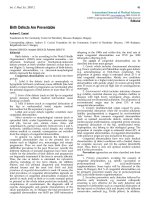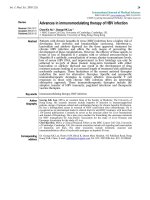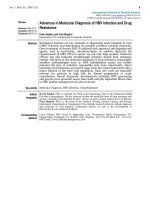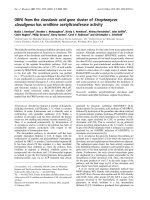Báo cáo y học: " Polysaccharides from the root of Angelica sinensis protect bone marrow and gastrointestinal tissues against the cytotoxicity of cyclophosphamide in mice
Bạn đang xem bản rút gọn của tài liệu. Xem và tải ngay bản đầy đủ của tài liệu tại đây (412.37 KB, 6 trang )
Int. J. Med. Sci. 2006, 3
1
International Journal of Medical Sciences
ISSN 1449-1907 www.medsci.org 2006 3(1):1-6
©2006 Ivyspring International Publisher. All rights reserved
Research paper
Polysaccharides from the root of Angelica sinensis protect bone marrow and
gastrointestinal tissues against the cytotoxicity of cyclophosphamide in mice
Marco K. C. Hui, William K. K. Wu, Vivian Y. Shin, Wallace H. L. So and Chi Hin Cho
Centre of Infection and Immunology and Department of Pharmacology, Faculty of Medicine, The University of Hong Kong, Hong
Kong, China
Corresponding address: Prof. C.H. Cho, Department of Pharmacology, The University of Hong Kong, 21 Sassoon Road, Hong
Kong, China. Email: Telephone: 852-2819-9250 Fax: 852-2817-0859
Received: 2005.09.08; Accepted: 2005.12.15; Published: 2006.01.01
Cyclophosphamide (CY) is a cytostatic agent that produces systemic toxicity especially on cells with high proliferative
capacity, while polysaccharides from Angelica sinensis (AP) have been shown to increase the turnover of gastrointestinal
mucosal and hemopoietic stem cells. It is not known whether AP has an effect on CY-induced cytotoxicity on bone
marrow and gastrointestinal tract. In this study, we assessed the protective actions of AP on CY-induced leukopenia
and proliferative arrest in the gastroduodenal mucosa in mice. Subcutaneous injection of CY (200 mg/kg) provoked
dramatic decrease in white blood cell (WBC) count and number of blood vessels and proliferating cells in both the
gastric and duodenal mucosae. Subcutaneous injection of AP significantly promoted the recovery from leukopenia and
increased number of blood vessels and proliferating cells in both the gastric and duodenal tissues. Western blotting
revealed that CY significantly down-regulated the protein expression of vascular endothelial growth factor (VEGF), c-
Myc and ornithine decarboxylase (ODC) in gastric mucosae but had no effect on epidermal growth factor (EGF)
expression. AP also reversed the dampening effect of CY on VEGF expression in the gastric mucosa. These data
suggest that AP is a cytoprotective agent which can protect against the cytotoxicity of CY on hematopoietic and
gastrointestinal tissues when the polysaccharide is co-administered with CY in cancer patients during treatment
regimen.
Key words:
Angelica sinensis
, polysaccharides, cyclophosphamide, leukopenia, gastrointestinal tract, angiogenesis
1. Introduction
The major side effect of anticancer drugs, e.g.
cyclophosphamide, is the non-specific cytostatic action on
normal healthy cells, especially those with high
proliferating capacity like the hematopoietic and GI tissues
[1]. The extensive death of the immune cells results in
leukopenia which severely weakens the immune system of
cancer patients and therefore greatly increases the chance
of disseminated infections which could be fetal. As a
result, drug-free period is always clinically necessary in
cancer patients receiving chemotherapy, so as to allow
their immune systems to restore function [2]. On the other
hand, the death of GI cells breaks down the physical
defence of GI system in the host who will become more
susceptible to antigen originated from GI systems and
therefore further increases death rate due to opportunistic
infection [3]. In addition, emesis due to the release of
serotonin from enterochromaffin cells is also discouraging
to cancer patients [4]. All of these are the main reasons for
discontinuation of cancer chemotherapy, which lowers the
chance of a successful and complete treatment regimen.
Angelica sinensis, also known as Danggui, has been
used as a medicinal herb in China for thousands of years
and renowned for its therapeutic effects on gynecological
disorders, such as amenorrhea and menopause [5]. Recent
pharmacological studies demonstrated the polysaccharides
fraction of Angelica sinensis had radio-protective effects in
irradiated mice through modulation of proliferative
response of hemopoietic stem cells [6]. Concerning
gastrointestinal system, AP was known to be protective
against ethanol- or indomethacin-induced mucosal damage
[7]. It was also reported that Angelica sinensis crude extract
increased the proliferation of gastric epithelial cells
through modulation of several proliferation-related genes,
including EGF, ODC, and c-Myc [8-10]. In addition to the
effect on hemopoietic and gastrointestinal tissues, AP was
also shown to possess anti-tumor effect [11, 12]. However,
the protective effect of AP on CY-induced cytotoxicities in
both the hemopoietic and gastrointestinal tissues was
undefined. Any of these actions would extend the
therapeutic application of CY in cancer patients in which
the herb could be used together with the cytotoxic agent in
cancer therapeutic regimen.
In the present study, we investigated whether AP
could protect the bone marrow and the gastrointestinal
tissues from the cytotoxicity of CY in mice. We also
profiled the changes of the expression of growth factors in
gastric tissues in response to the damage by CY and
protection by AP.
2. Materials and Methods
Chemicals and Reagents
All chemicals and reagents were of analytical grade
and were purchased from Sigma (Sigma-Aldrich,
St. Louis,
MO, USA) unless otherwise specified.
Preparation of Angelica sinensis Polysaccharides
The roots of Angelica sinensis (Oliv.) Diels, Danggui,
were purchased from Minxian County, Gansu Province,
China. Polysaccharides fraction was isolated by the
ethanol precipitation method as described by Cho et al [7]
and modified by Ye et al. [10]. Briefly, one hundred grams
of roots of Angelica were boiled for three four-hour periods
with water for a total of 12 hours. After each four-hour
period of boiling, the water extract was collected and the
Int. J. Med. Sci. 2006, 3
2
residue was boiled again with water for another four-hour
period. All extracts were finally pooled and mixed with a
concentrated ethanol solution (final concentration 75%
v/v) to precipitate the polysaccharide-enriched fraction.
Two kinds of high performance liquid chromatography
(HPLC) methods including the high performance anion
exchange and the gel filtration chromatography,
respectively [13], were employed to concentrate and
determine the molecular size of the polysaccharide-rich
fraction. The molecular sizes of polysaccharides were
determined in HPLC (gel filtration column, Biosep SEC-
S3000, Phenomenex, USA; mobile phase 0.15 mol/L NaCl
solution; detector wavelength 220 nm) combined with the
phenol-sulfuric acid method [14, 15]. The amounts of
uronic acids and proteins were also determined [16, 17].
The Angelica polysaccharide fraction was found to
consist of 5 main polysaccharide sub-fractions with the
following moleculard weights: >670.00, 433.72, 167.55,
82.10 and 15.54 kD respectively. The total extracted
fraction consisted of 97% carbohydrates (about 30% of
them uronic acids) and 3% proteins. This polysaccharide-
enriched fraction from Angelica sinensis (AP) was dissolved
in normal saline (0.9%, w/v, NaCl) before subcutaneous
injection to animals.
Experimental animals and drug administration
This study was conducted with the consent of the
Committee on the Use of Live Animals in Teaching and
Research of the University of Hong Kong. Male ICR mice
(weighing 25–30 g) were reared on a standard laboratory
diet (Ralston Purina, Chicago, Illinois, USA) and given tap
water ad libitum. Mice were randomly allocated into 5
treatment groups (n = 8 - 15 in each group) which were
subject to a 14-day treatment. Group 1 was the normal
untreated control (Nor) while groups 2 to 5 received a
single dose of CY 200 mg/kg daily by subcutaneous
injection on day 0 and day 7. In addition, group 2 (NS)
mice received daily dose of normal saline while groups 3 to
5 mice received daily dose of AP at 5 (AP5), 10 (AP10) or 25
(AP25) mg/kg, respectively. Mice were sacrificed on day
14 and the gastric and duodenal tissues were collected for
biochemical and histological assessments.
Assessment of white blood cell (WBC) count
Blood samples were collected from the tail arteries on
day 0, 4, 7, 11 and 14 to monitor the toxicity of CY on bone
marrow by measuring WBC number in the peripheral
blood. Twenty microliters of blood was mixed with 380μl
of Randolph’s solution. WBC counting was then performed
by using an improved Neubauer hematocytometer
(Reichert, U.S.A.).
Assessment of angiogenesis
Immunohistochemical staining of microvessels in the
tissues of stomach and duodenum was performed by using
von Willebrand factor antibody [18]. The prepared sections
were incubated with 0.3% H
2
O
2
in methanol and then
trypsinized in 0.1% trypsin for 30 minutes at room
temperature followed by washing with 0.01 M phosphate-
buffered saline. The sections were then incubated for 1
hour with 1.5% normal goat serum, and subsequently
incubated with polyclonal rabbit anti-human von
Willebrand factor antibody at dilution of 1:500 in a
humidified chamber overnight at 4 °C. Endothelial cells of
blood vessel were then visualized by applying the DAKO-
staining system (LSAB kit, DAKO, Copenhagen,
Denmark). Blood vessels stained with the antibody to von
Willebrand factor were counted with Leica image
processing and analysis system at a 200x magnification
(Q500IW, Leica Imaging Systems, Cambridge, UK).
Assessment of cell proliferation
To determine the number of proliferative cells,
proliferating cell nuclear antigen (PCNA) in gastric and
duodenal tissues was stained according to the method
described by Kitajima et al. [19] with some modifications.
Briefly, re-hydrated sections were immersed in 0.3% H
2
O
2
solution, followed by immersion in diluted normal serum
for 1 hour in a humidified container at room temperature.
They were incubated with anti-PCNA mouse monoclonal
antibody (PC10, Santa Cruz, USA) in a humidified
container at 4 °C overnight followed by a 45-minute
incubation in peroxidase-labeled streptavidin (from DAKO
kit). Finally the sections were stained with
diaminobenzidine-H
2
O
2
solution at room temperature.
The number of stained cells was counted under microscope
(Q500IW, Leica Imaging Systems, Cambridge, UK) with a
400x magnification.
Western blotting
Protein expressions of VEGF, EGF, ODC and c-Myc in
gastric tissues were assessed by Western blot analysis.
Briefly, gastric tissues were homogenized (100 mg/ml) for
30 seconds in a radioimmune precipitation assay buffer
(50 mM Tris–HCl, pH 7.5, 150 mM sodium chloride, 0.5%
α-cholate, 0.1% sodium dodecyl sulphate (SDS), 2 mM
EDTA, 1% Triton X-100 and 10% glycerol), containing
1.0 mM phenylmethylsulfonyl fluoride and 1 μg/ml
aprotinin. Samples were then centrifuged at 12,000 rpm for
20 min at 4 °C and the supernatant containing total protein
was denatured and separated by electrophoresis on a SDS-
polyacrylamide gel (The percentage of the gel was 15% for
VEGF, 15% for EGF, 10% for ODC and 10% for c-Myc
protein). The protein was then transferred to a
nitrocellulose membrane (Bio Rad, Hercules, CA, USA)
that was probed with primary antibody against VEGF
(1:250, Santa Cruz, USA), EGF (1:250, Santa Cruz, USA),
ODC (1:250, NeoMarkers, USA) or c-Myc (1:250, Santa
Cruz, USA). Membranes were developed by using
enhanced chemiluminescence (ECL) solution and exposed
on X-ray film. Quantification of bands on the film was
carried out by video densitometry (Gel Doc 1000, Bio Rad,
Hercules, USA).
Statistical Analysis
Results are expressed as the mean ± standard error
(S.E.), and statistical comparisons were based on unpaired
Student’s t test. A p-value of less than 0.05 was considered
as statistically significant.
3. Results
Effects of Angelica polysaccharides on the recovery from
cyclophosphamide-induced leukopenia
Subcutaneous administration of CY resulted in a
significant drop in WBC number on day 4 and 11 (80% and
88% respectively) in mice. Recovery of WBC count started
on day 4 and day 11 in all treatment groups and returned
back to the normal level on day 7 and day 14 in NS group.
AP at all doses did not have any effect on peripheral WBC
count in CY-treated mice on either day 4 or day 11.
However, the rate of recovery of WBC number in mice
treated with AP 5 mg/kg was significantly increased. In
Int. J. Med. Sci. 2006, 3
3
NS group, the time needed for WBC number to recover
back to normal level was 7 days. Upon administration of
AP 5mg/kg once daily, the WBC number could recover in
5-day period (Fig. 1).
Figure 1. Effects of Angelica sinensis polysaccharides (AP)
treatment (given subcutaneously once daily) on white blood cell
(WBC) number in cyclophosphamide (CY)-treated mice. CY was
given subcutaneously (200 mg/kg) at day 0 and day 7 and AP
was also injected subcutaneously once daily during the 14-day
experimental period. Nor: Normal untreated group; NS: normal
saline plus CY-treated group; AP5: AP 5 mg/kg plus CY-treated
group, AP10: AP 10 mg/kg plus CY-treated group, AP25: AP 25
mg/kg plus CY-treated group, respectively.
*
P <0.001 compared
to Nor.
†
P< 0.05, compared to NS.
0.00
50.00
100.00
150.00
200.00
250.00
day 0 day 4 day 7 day 11 day 14
Nor
NS
AP5
AP10
AP25
WBC no (x100/mm
3
)
†
*
*
†
Figure 1
Figure 2. Effects of Angelica sinensis polysaccharides (AP)
treatment (given subcutaneously once daily) on the blood vessel
count in (A) gastric and (B) intestinal mucosae in
cyclophosphamide (CY given subcutaneously 200 mg/kg)-treated
mice. Nor: Normal untreated group. NS: normal saline plus CY-
treated group. AP5: AP 5 mg/kg plus CY-treated group, AP10:
AP 10 mg/kg plus CY-treated group, AP25: AP 25 mg/kg plus
CY-treated group, respectively. *P< 0.05, compared to Nor.
†
P<
0.05 compared to the NS.
0
1
2
3
4
5
6
7
Number of blood vessels per field
Nor NS AP5 AP10 AP25
*
†
†
†
A
Figure 2
0
1
2
3
4
5
6
Number of blood vessels per field
Nor NS AP5 AP10 AP25
†
†
*
B
Figure 2
Effects of Angelica polysaccharides on angiogenesis in gastric
and intestinal mucosae
CY administration significantly decreased the number
of blood vessels in both the gastric (23%, Fig. 2A) and
duodenal (25%, Fig. 2B) mucosae. AP at the doses of 5, 10
and 25 mg/kg significantly increased the blood vessel
count per field by 36%, 55% and 64% respectively in gastric
mucosa. For duodenal mucosa, only AP 10 and 25 mg/kg
had significant effects on blood vessel number (an increase
of 40% and 57% respectively). Dose-dependent effect was
observed in both gastric and duodenal tissues.
Effects of Angelica polysaccharides on cell proliferation in
gastric and duodenal mucosae
Subcutaneous CY administration significantly
decreased the number of proliferating cell by 48% in gastric
(Fig. 3A) and by 74% (Fig. 3B) in duodenal mucosae.
Concerning gastric mucosa, AP 5 mg/kg increased the
proliferating cell number by 29% while there was a 154%
and 208% increase in AP10 and AP25 group respectively
when compared to NS group (Fig. 3A). Dose dependent
effect was observed. Concerning duodenal mucosa, AP at
the doses of 5 and 10 mg/kg significantly increased the
proliferating cell count in duodenal mucosa by 131% and
305% respectively (Fig. 3B). AP 25 mg/kg however, led to
an increase of only 93% when compared to the vehicle
control group (Fig. 3B).
Effects of Angelica polysaccharides on VEGF, c-Myc, ODC
and EGF protein expressions in gastric musoca
As we had demonstrated that both the blood vessel
and proliferating cell counts in gastric and duodenal
tissues were significantly affected by CY and AP
treatments, the expression level of angiogenesis- and
proliferation-related proteins were studied. CY
significantly down-regulated the protein levels of VEGF, c-
Myc and ODC in the gastric mucosa (Fig. 4A, 4B and 4C
respectively). There was a 73% decrease in the VEGF
protein level and a 22% decrease in the c-Myc protein level
in the corresponding NS group. A 52% decrease in the
expression level was noted in the ODC protein expression
assay. In contrast, EGF expression was not altered (Fig.
4D). AP treatment only significantly reversed the
dampening effect of CY on VEGF expression in a dose-
dependent manner (Fig. 4A). It was observed that AP 5
mg/kg resulted in an increase of 75% while both AP 10 and
25 mg/kg doubled the increase in the VEGF protein
Int. J. Med. Sci. 2006, 3
4
expression. AP treatment did not have any effect on the
expression of c-Myc, ODC and EGF in the gastric mucosa
(Fig. 4B, 4C and 4D respectively).
Figure 3. Effects of Angelica sinensis polysaccharides (AP)
treatment (given subcutaneously once daily) on the number of
proliferation cells in (A) gastric and (B) duodenal mucosae in
cyclophosphamide (CY) given subcutaneously 200 mg/kg-treated
mice. Nor: Normal untreated group. NS: normal saline plus CY-
treated group. AP5: AP 5 mg/kg plus CY-treated group, AP10:
AP 10 mg/kg plus CY-treated group, AP25: AP 25 mg/kg plus
CY-treated group, respectively. * p<0.05, compared to Nor.
†
P<0.05 compared to NS.
0.00
10.00
20.00
30.00
40.00
50.00
60.00
70.00
80.00
90.00
100.00
Nor NS AP5 AP10 AP25
Number of proliferating cells per field
*
†
†
†
A
Figure 3
0.00
10.00
20.00
30.00
40.00
50.00
60.00
Nor NS AP5 AP10 AP25
N
u
m
b
e
r
o
f
p
r
o
l
i
f
e
r
a
t
i
n
g
c
e
l
l
s
p
e
r
f
i
e
l
d
*
†
†
†
B
Figure 3
Figure 4. Effects of Angelica sinensis polysaccharides (AP)
treatment (given subcutaneously once daily) on the protein
expression (in terms of % of change from control) of (A)
vascular endothelial growth factor (VEGF), (B) c-Myc, (C)
ornithine decarboxylase (ODC), and (D) epidermal growth factor
(EGF) in the gastric mucosa in cyclophosphamide (CY given
subcutaneously 200 mg/kg)-treated mice. Nor: Normal untreated
group. NS: normal saline plus CY-treated group. AP5: AP 5
mg/kg plus CY-treated group, AP10: AP 10 mg/kg plus CY-
treated group, AP25: AP 25 mg/kg plus CY-treated group,
respectively. * P< 0.05 compared to Nor.
†
P< 0.05 compared to
NS.
0
20
40
60
80
100
120
Nor CY+NS CY+AP5 CY+AP10 CY+AP25
Normal CY treated
AP 0 5 10 25 (mg/kg)
*
††
††
††
Figure 4
A
VEGF protein expression
(% of change from control)
AP 0 5 10 25 (mg/kg)
Normal CY treated
0.00
20.00
40.00
60.00
80.00
100.00
120.00
Nor CY +NS CY +A P5 CY +A P10 CY +A P25
*
Figure 4
B
C-Myc protein expression
(% of change from control)
Int. J. Med. Sci. 2006, 3
5
0.00
20.00
40.00
60.00
80.00
100.00
120.00
Nor CY+NS CY+AP5 CY+AP10 CY+AP25
Normal CY treated
AP 0 5 10 25 (mg/kg)
*
Figure 4
C
ODC protein expression
(% of change from control)
0.00
20.00
40.00
60.00
80.00
100.00
120.00
140.00
160.00
Nor CY+NS CY+AP5 CY+AP10 CY+AP25
Normal CY treated
AP 0 5 10 25 (mg/kg)
Figure 4
D
EGF protein expression
(% of change from control)
4. Discussion
In this study, CY produced myelosuppression
manifested as leukopenia (Fig. 1). It also significantly
reduced the blood supply and proliferating cell number in
both the gastric and duodenal mucosae. Subcutaneous
administration of AP at the dose of 5 mg/kg daily
significantly promoted the recovery rate of immune system
in mice in a 14-day treatment (Fig. 1). It also significantly
increased the number of blood vessel and PCNA-positive
cell in both the gastric (Fig. 2A and 2B respectively) and
duodenal tissues (Fig. 3A and 3B respectively). Dose-
dependent effects were observed in general. Western blot
analysis implicated the reduction by CY and normalization
by AP of blood vessel count was VEGF dependent in
gastric tissue (Fig. 4A). On the other hand, the decrease in
proliferating cell number in gastric mucosa by CY
administration was found to be c-Myc and ODC-
dependent (Fig 4B and 4C respectively).
CY is the non-cytostatic drug that acts non-specifically
on both tumor cells and normal healthy cells with high
proliferating capacity like immune cells and GI tissues. It
exerts its cytotoxic effect via transfer of its alkyl groups to
DNA, leading to cell cycle arrest and apoptosis. The major
site of alkylation within the DNA is the N7 position of
guanine. Alkylation of guanine results in depurination by
excision of guanine residues, causing DNA strand
breakage through scission of the sugar-phosphate
backbone [3]. Patients under chemotherapeutic regimen
are often subject to leukopenia which greatly increases the
chance of opportunistic infections. As a result drug-free
period is routinely introduced during regimen to prevent
any or even fetal infections. In this model, we showed that
7 days were needed for the CY-treated mice to restore their
immunity to normal level as indicated by WBC count.
Such a long drug-free period is indeed undesirable because
it allows the restoration of tumor tissue into active
proliferating stage [2], as vascular endothelial cells can
proliferate again and tumor will be nourished by supply of
nutrients and oxygen. However, in mice treated with AP
5mg/kg, it was observed that a 5-day drug free period was
enough to fully restore their normal immune response (Fig.
1). The present findings suggest that AP has
immunostimulatory effect which can accelerate the
recovery from leukopenia induced by CY and thereby
shortens the drug-free period to allow a more frequent
administration of anticancer drug e.g. CY so as to increase
the efficacy of chemotherapy. In previous studies, AP has
been shown to activate polyclonal B cells [20], induce
interferon [21] and also activate helper T cells [22].
Lymphocyte proliferation assays, e.g. mitogen-mediated
lymphocyte proliferation test and mixed lymphocyte
culture also proved that AP could increase the rate of
lymphocyte proliferation in vitro [23]. Oral administration
of You-Gui-Wan, a classical prescription of TCM
containing AP, was shown to protect mice against
hydrocoticoid-induced inhibition of IFN-γ, IL-2, IL-4 and
IL-10 transcription [24]. In addition, vitamin B12, folinic
acid and biotin identified in AP may also contribute to
stimulated hematopoiesis [25]. All of these results are
consistent with the present findings that AP is a tonic to
hematopoietic system.
Concerning angiogenesis, it is believed that one of the
anti-tumor mechanisms of CY is through the suppression
on endothelial cell growth in tumor bed [26]. In addition,
the down-regulation of VEGF by CY has been shown to be
due to p53 activation [27]. This would decrease the blood
supply to cancer cells so as to reduce nutrients and oxygen
to support the growth and differentiation of tumor.
However, it would also adversely affect the repairing
capacity and the defensive mechanism of the GI mucosae
that have been damaged during chemotherapy. In this
regard, AP was shown to be beneficial to cancer patients
because it normalized blood vessel number, which could
probably supply more nutrients and oxygen to gastric and
duodenal mucosae. This also promoted the defensive
mechanism and also the repairing capacity of the GI
system which has been damaged by CY administration.
However, it should be noted that AP might also have a
similar effect on the vascular endothelial cells in tumor
bed, of which the proliferation and differentiation would
be enhanced with a good supply of blood flow. Whether
or not AP could affect blood vessels in tumors remains
unknown. In this regard, further studies are needed to
clarify this phenomenon.
CY exerts its cytotoxicity by cross-linking DNA
strands and activation of p53-dependent growth arrest and
apoptosis [28]. It was therefore not surprising that CY
administration resulted in a decrease in the proliferating
cell number in both the gastric and duodenal tissues.
Indeed the decrease in cell proliferation in gastric tissue
was supported by the down-regulation of c-Myc and ODC
protein in the Western Blot analysis (Fig. 4B and 4C). It has
been reported that p53 activation suppresses the
transcription of c-Myc, an immediate early gene related to









